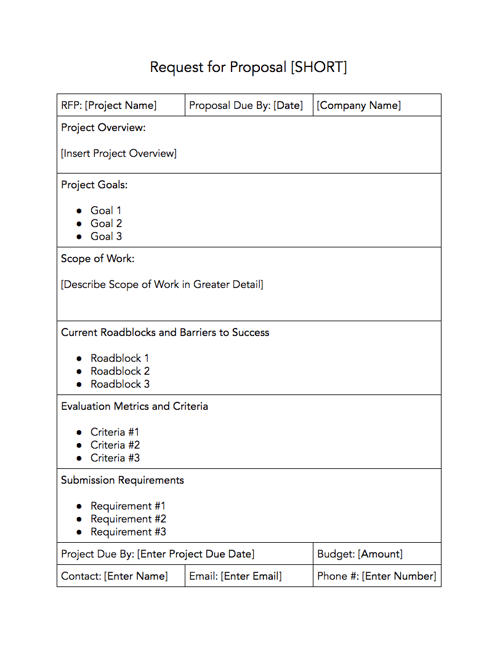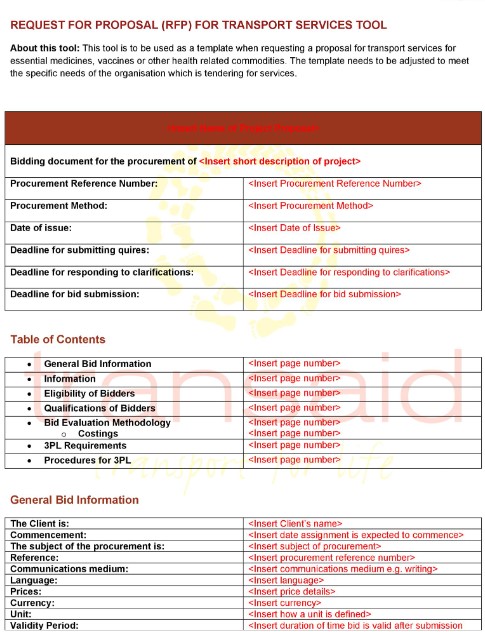Whether you’re working for a small agency or a major marketing firm, you’re probably eventually going to need to fill out a Request for Proposal, or RFP.
Your company can’t do everything internally, and when your business needs to purchase a product or service from elsewhere, you might need to shop around. An RFP allows you to collect offers from various vendors and select the vendor that best meets your criteria, both in regards to skill and budget.
Any time you outsource work to a supplier, there's a potential for issues such as miscommunication around the scope of the work and the compensation. What a good RFP does is eliminate gray area so that both parties understand what needs to be delivered, when, and for how much.
RFP Template
Here, we’ve provided an RFP template you can follow for initial structure, as well as a sample RFP for further inspiration. But it isn’t one-size-fits-all -- you’ll need to tailor your RFP to best articulate your company’s needs.

Download this Template for Free
RFPs come in all shapes, sizes, and visual formats depending on the needs of your company and the work that must be performed. At the top of a standard RFP, you'll find the following:
Project Name or Description
Company Name
Address
City, State, Zip Code
Procurement Contact Person
Telephone Number of PCP
Email Address of PCP
Fax Number
The body of the RFP will contain additional details about the project, including:
- Background/Introduction
- Project Goals and Scope of Services
- Anticipated Selection Schedule
- Time and Place of Submission of Proposals
- Timeline
- Elements of Proposal
- Evaluation Criteria
- Possible Roadblocks
- Budget
Read on to learn more about what goes into each of these sections so that you can build an RFP of your own.
1. Background/Introduction
In your introductory paragraph, you’ll want to include useful background information about your company -- who founded it, what product or service your company offers, what sets you apart from competitors, and where you’re located. If any vendor is serious about working with you, they’ll want this information before moving forward.
2. Project Goals and Scope of Services
Next, you’ll want to outline the project you need completed, and the goals you expect to accomplish from the project. It’s important you get as specific as possible — even outlining individual tasks and criteria involved. You’ll want to include phrases such as “The award will be given to X firm,” with the “X” establishing how you’ll determine the best candidate.
3. Anticipated Selection Schedule
It’s crucial you include a detailed schedule so vendors know if they can meet your deadlines. You’ll also need to give vendors a window for when they can ask questions regarding your project. This’ll limit the hassle, for you and for them.
4. Time and Place of Submission of Proposals
Similar to paragraph #3, this is important information you’ll want to clearly present, so vendors know how and where to submit themselves for consideration.
5. Timeline
By including a time frame in your RFP, you’re able to eliminate any vendor who can’t work within your time constraints. If you’re flexible on your time, you can write something like, “Our company hopes to finish the project within six months, but we’re open to negotiation for the right candidate.”
6. Elements of Proposal
If you don’t outline clearly and specifically what you expect bidders to include in their proposal, you can’t necessarily fault them if they don’t include it. It’s critical you outline a checklist so vendors know which elements you’re expecting to receive. It’s also a good test for who’s capable of handling your demands — if a vendor can’t complete all elements of your proposal, you probably can’t trust them to finish your project, either.
7. Evaluation Criteria
Outlining your expectations will help eliminate vendors who don’t meet them. For this section, you’ll want to do some brainstorming with your team to come up with a mandatory list of items you feel are the best indicators of impressive candidates. Your list could include samples of past work, a proven success record with companies in similar industries, the expertise and technical skills to meet your demands, and a cost of services within your price range.
8. Possible Roadblocks
Here, you’ll want to outline any roadblocks, such as limited resources or a custom website, that might prevent certain vendors from successfully completing the project. This allows you to eliminate unsatisfactory bidders, and it will also help you determine which vendors have the skills and expertise to tackle those challenges.
9. Budget
Any vendor needs to know how much you’re able to pay them for their services before they’ll move forward with their bid.
RFP Sample
The above elements might manifest on the page in a number of ways. For example, here is an RFP sample from TemplateLab.
Now that you understand the elements of an RFP , you can build your own template and then fill it out so that you can start accepting bids. We'll use a fictitious company, Caroline's Websites, Inc., to illustrate exactly how each section should be executed, starting with the header:
Project Name or Description: Marketing Services
Company Name: Caroline’s Websites, Inc.
Address: 302 Inbound Ave.
City, State, Zip Code: Boston, MA 29814
Procurement Contact Person: Caroline Forsey
Telephone Number of PCP: 227-124-2481
Email Address of PCP: cforsey@consulting.com
Fax Number: N/A
Next, we'll go into each of the elements of the RFP with information using the same fictitious company.
1. Background/Introduction
Caroline’s Websites, Inc. is a web design firm created by Caroline Forsey in 2010. Caroline’s Websites, Inc. prides itself on a team-oriented, solutions-based approach to web design. We provide our clients with web design services including coding, development, and branding. Our staff is located in two offices in Massachusetts.
2. Project Goals and Scope of Services
Caroline’s Websites, Inc. is seeking the services of a full-service communications and marketing firm to develop and execute a comprehensive integrated marketing plan that increases our SEO presence; attracts more social media followers; and effectively completes a lead generation campaign. The award will be made to a responsive and responsible firm based on the best value and professional capability.
The selected firm will be responsible for the development and implementation of a comprehensive and cost-effective marketing plan.
Tasks include but may not be limited to the following criteria:
• Lead generation campaign
• Paid media strategy
• Production of creative material including collateral and direct mail
• Online marketing campaign
• Website enhancement
• Search engine optimization
• General account management
• Other communications and/or marketing-related assistance as required
3. Anticipated Selection Schedule
The Request for Proposal timeline is as follows:
Request for RFP: June 1, 2020
Deadline for Bidders to Submit Questions: July 5, 2020
[Company Name] Responds to Bidder Questions: July 20, 2020
Selection of Top Bidders / Notification to Unsuccessful Bidders: July 31, 2020
Start of Negotiation: August 5, 2020
Contract Award / Notification to Unsuccessful Bidders: August 31, 2020
4. Time and Place of Submission of Proposals
The RFP will be posted on our website, Carolinewebsites.com, and can be downloaded from there directly as of 10 a.m. on June 1, 2020.
Respondents to this RFP must submit one original and five copies of their proposal. Responses must be received no later than July 25, 2020. Responses should be clearly marked “RFP-MarketingServices” and mailed or delivered to the contact person listed above.
5. Timeline
Caroline’s Websites, Inc. needs the project completed within 8 months.
6. Elements of Proposal
A submission must, at a minimum, include the following elements:
• Description of the firm that includes a general overview, names and credentials of creative team, number of full-time employees.
• A one-page narrative outlining the firm’s strengths and distinguishing skills or capabilities as they might relate to Caroline’s Websites, Inc.
• A representative selection of social media ads, direct response material, collateral, and website development created for current and past clients.
7. Evaluation Criteria
The successful respondent will:
• Have been operating continuously as a marketing agency for a minimum of 24 months and possess full-service, in-house capabilities for marketing, creative services, production, media planning and placement, direct response and research.
• The education, experience, knowledge, skills, and qualifications of the firm and the individuals who will be available to provide these services.
• The competitive cost of services.
• The expertise of the firm in working with similar customers.
8. Possible Roadblocks
At this time, Caroline’s Websites, Inc. currently has custom coding on our website, of which bidders should be aware.
9. Budget
Caroline’s Websites, Inc.’s budget for the project is $8,750.00.
These elements were written in a way to clarify the scope of the project that Caroline's Websites, Inc. wants completed so that suppliers know whether or not to make a bid. Defining the project allows the bidder to determine if they're a good fit and how much they'd likely charge. Being as transparent as possible serves to benefit (and even protect) both parties in the long run.
To use some of these elements in your own RFP, start with an RFP template and adjust it to your liking.
Editor's note: This post was originally published in June 2018 and has been updated for comprehensiveness.

No comments:
Post a Comment